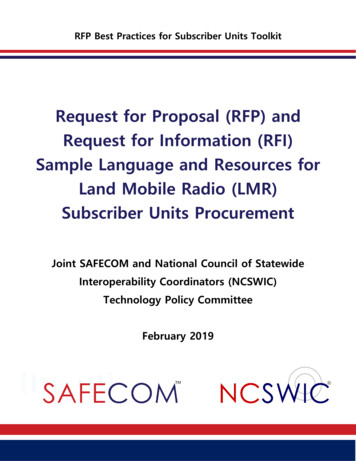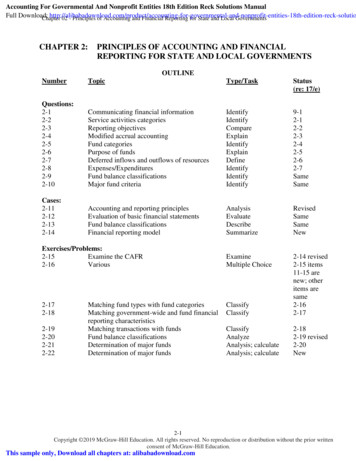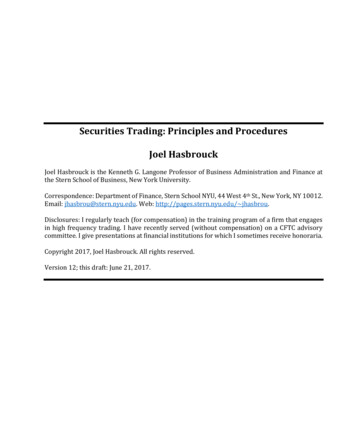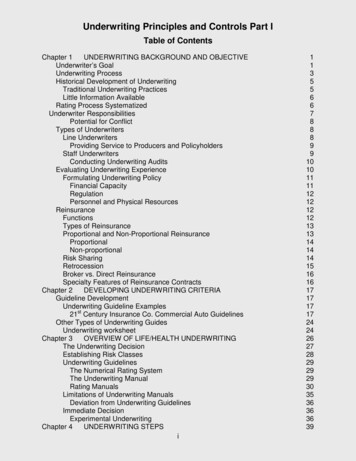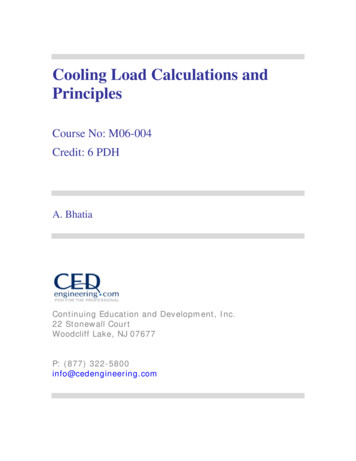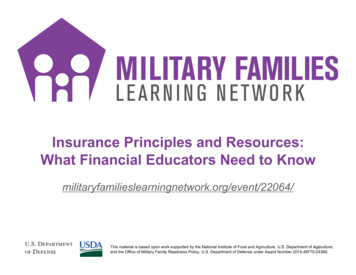
Transcription
Insurance Principles and Resources:What Financial Educators Need to 4/This material is based upon work supported by the National Institute of Food and Agriculture, U.S. Department of Agriculture,1and the Office of Military Family Readiness Policy, U.S. Department of Defense under Award Number 2015-48770-24368.
Connecting military family service providersand Cooperative Extension professionals to researchand to each other through engaging online learning is material is based upon work supported by the National Institute of Food and Agriculture, U.S. Department of Agriculture,2and the Office of Military Family Readiness Policy, U.S. Department of Defense under Award Number 2015-48770-24368.
Today’s PresenterDr. Barbara O’NeillFinancial Resource ManagementSpecialist for Rutgers CooperativeExtensionShe earned a Ph.D. in family financialmanagement from Virginia Tech and hasreceived over three dozen awards forprofessional achievements and over 900,000 in funding for financial educationprograms and research.3
Why a Webinar About Insurance? Insurance is a complex topic:– Lots of types and terminology– Many personal decisions (e.g., coverage, deductible) A topic educators feel least confident teaching:http://afcpe.org/assets/pdf/vol20 2way holden.pdf4
TeroVesalainen/Pixabay.comWhat Are the Most FrequentInsurance Questions orIssues That Your Hear FromClients?
Webinar Topics Basic insurance terms Auto insurance Homeowners and renters insurance Umbrella insurance Life insurance Health insurance Disability insurance Long-term care insurance6
Life is Full of Risks Many HaveFinancial Consequences Damage to car in an accident Loss of home and/or possessions Loss of income due to disability Loss of a household earner’s income Loss of a homemaker’s services Large medical bills for disease or injury A court judgment of liability for damages7
Five Ways to Manage Risk1. Do nothing andhope for the best3. Risk reduction4. Risk acceptanceComfreak/Pixabay.com2. Risk avoidance5. Risk transfer(insurance)8
Types of Financial Risk Personal Risks– Loss of income or life– Illness and disability Property Risks– Losses to property– Caused by perils such as fire ortheft Liability Risks– Losses caused by negligence– Resulting in injury or propertydamage to others12019/Pixabay.com9
How Insurance WorksInsurance Policy – Contract between a person buyinginsurance (the insured) and an insurance company(the insurer).10
The Essence of Insurance Insurance consists of two basic elements:1. Reduction of risk2. Sharing of losses Law of Large Numbers – As the number ofmembers in a group increases, predictions about thegroup’s behavior become increasingly more accurate11
An Insurable Interest MustExist to Buy Insurance Insurable Interest – When a person or organizationstands to suffer a financial loss from a specific risk Example #1: The person that lives in an house thatis insured Example #2: The spouse of a person who iscovered by life insurance12
Insurance Basics Protect against risk by paying a premium “Large Loss Principle” (size of loss matters) Major “large-loss” risks:– Loss of income due to disability– Loss of a household earner’s income– Destruction of one’s home (fire, flood, etc.)– Liability losses due to a court judgment– Large medical expenses (e.g., cancer treatment)13
Common Insurance Errors Not following the “large loss principle” Unfamiliarity with employer-provided (and public)insurance benefits Lack of disability insurance Lack of adequate liability insurance Not checking credit rating of insurance companies14
Parts of an Insurance Contract Declarations page Insuring Agreements Exclusions Endorsements and RidersGeralt/Pixabay.com15
Policy Features That Limit Coverage Benefit coordination clauses Deductible Elimination period Co-payment Co-insurance Policy limit16
General Insurance Tips Insure for major losses Choose a highly rated insurance company Select the highest deductible you can afford Pay premiums annually or semi-annually Avoid duplicating coverage Ask about available discounts Follow “The Rule of Three”17
TeroVesalainen/Pixabay.comAny Questions or Additions onInsurance Basics?
Property and Liability Insurance Home, automobiles, furniture, clothing, personal belongings– Risk #1: Physical damage caused by perils (e.g., fire)– Risk #2: Loss or damage caused by criminal behavior Liability Legal responsibility for the financial cost of anotherperson’s losses or injury (if you are held legally liable)– Liability due to negligence– Vicarious liability for actions of another person, such as achild19
Factors That Affect Auto Insurance Vehicle Type– Year, make, model, andtheft rate Rating Territory– Accident, auto theft, andvandalism rates in thearea where you live DriverClassification– Age, sex, marital status,credit history, drivingrecord, driving habitsToby Parsons/Pixabay.com– Assigned risk pool forthose unable to obtaininsurance20
Factors That Affect Auto InsuranceReducing Automobile Insurance Premiums Compare Companies Premium Discounts– Establishing and maintaining a good driving record– Installing security devices such as a car alarm– Multiple policies with the same company– Larger deductibles21
Motor Vehicle BodilyInjury Coverage Medical Payments Coverage– Covers health care for persons injured in your car, including yourself– Also covers you or family members injured while riding in or hit byanother vehicle Uninsured Motorist’s Protection– Protection against the risk of getting into an accident with someone withno insurance Underinsured Motorist’s Coverage– Pays costs if your car is hit by a person who doesn’t have enoughinsurance to cover the damage they did to you and your car22
Automobile Liability Insurance PolicyLimitsSource: Personal Finance by Garman and Forgue, Houghton-Mifflin (2017)23
State Auto Insurance Liability Limits Vary from state to state– New Jersey: 15 per person/30 per accident/5property damage– Florida: 10 property damage/10 personal injury While drivers may be “legal” with minimum limits,they do not have enough coverage to pay fordamages to others (i.e., they are under-insured) Do you know your state liability nimum-carinsurance-requirements-264547324
Collision CoveragePays for damage to your automobile, regardless of who isat fault.– If you are not at fault, your insurer will try to collect fromthe other driver’s property damage liability first.– Coverage limited to current retail value of your vehicleWetmount/Pixabay.com25
Comprehensive Physical DamageCovers damage to your vehicle not caused by acollision, such as:– Fire, theft, or vandalism– Glass breakage– Hail, sand, or wind storm– Falling objects or hitting an animal26
Homeowners Insurance– Covers damage to, or destruction of, your houseand other structures on the property Garage, tool shed, trees, and shrubs– Additional Living Expenses May be limited to 20-30% of property value May be limited to 6-9 months Covers housing costs when building is uninhabitable27
Homeowners Insurance Coverage– Personal Property Furniture, appliances and clothing Household inventory advisable A percentage of building coverage (e.g., 50%-75%) Limits on certain items such as jewelry– Personal Liability Coverage Covers injuries to others on property (e.g., fall on ice)– Specialized Coverage Earthquake endorsement Flood insurance policy28
Factors That AffectHomeowners Insurance Location of Home (e.g., rural vs. urban) Type of Structure (e.g., brick vs. wood) Coverage Amount and Policy Type Home Insurance Discounts– Alarm system– Smoke detectors– If you insure car with the same company (bundling) Company Differences– Compare costs and coverage29
Renters Insurance May be a requirement of tenants in leases, especiallythose with pets (liability concerns) Includes liability coverage, personal property coverageto replace belongings if damaged or stolen, andadditional living costs (if you can’t stay in apartment) Buy replacement cost coverage- not ACV Basic policy generally costs less than 20 per month30
How UmbrellaInsurancePolicies WorkProvides protection againstmajor claims; extends theliability limits of underlyinghomeowners and autoinsurance policiesSource: Personal Finance by Garmanand Forgue, Houghton-Mifflin (2017)31
TeroVesalainen/Pixabay.comAny Additional PropertyInsurance Recommendations?
Life Insurance Premium is based on life expectancy and projections forpayouts for persons who die (actuarial tables)– Older people pay more because they will die sooner– Age and gender are key variables (women live longer) Face Amount- Dollar value of protection listed in the policyand amount used to calculate the premium (e.g., 100,000) Group Term Insurance- Issued to people as members of agroup rather than as individuals33
Do You Need Life Insurance? Do you have people you needto protect financially? Will your death cause peoplefinancial hardship?Examples:– Spouse, children, or parentsdependent on income– Parents who co-signedSkeeze/Pixabay.comprivate student loans34
Why Do People NeedLife Insurance? Income-Replacement Needs – Lost income andemployee benefits resulting from premature death Major Expenses- Two examples are a mortgageand children’s college expenses Final Expenses – One-time medical and funeralexpenses occurring just prior to or after a death. Readjustment-Period Needs – Allows survivingspouse/family members to pay ongoing expenses35
Estimating Life InsuranceRequirements The Easy Method– 70% of your salary for seven years while your family adjusts– Assumes a typical family The DINK Method– Dual income, no kids– Assumes spouse earnings will continue– Cover funeral ½ debts The “Family Need” Method– More thorough than the first three methods– Considers employer provided insurance, Social Security benefits,income and assets36
Life Insurance Needs WorksheetSource: k-book-chapter-2
Buying Life Insurance Research insurance company ratings by majorrating firms: A. M. Best Standard and Poor’s Duff & Phelps Moody’s Weiss Research Talk to friends, colleagues, or advisors Online premium quote services38
Term Life InsuranceTerm Life– Protection for a specified period of time– At the end of term (or if you stop paying premiums),coverage stopsTypes of Term Insurance:– Renewable Term- Can renew; higher premium charged– Multiyear Level Term- Same premium for set period– Conversion Term- Allows change to permanent policy– Decreasing Term- Face value decreases over time39
Whole Life InsuranceStraight-Life or Whole-Life Insurance– Pay the premium as long as you live– Accumulates a cash value you can borrow against– Look carefully at the rate of return on your moneyTypes: Limited Payment Policy– Pay premiums for a stipulated period– Policy then “paid up” and you are insured for life Variable Life Policy- Fixed premiums; investment subaccounts Adjustable Life Policy- Can change coverage with needs Universal Life- Can change premium, time period, benefit40
Buy Term Life Insurance and Investthe Difference?Source: Personal Finance by Garman and Forgue, Houghton-Mifflin (2017)41
Servicemembers’ Group LifeInsurance (SGLI) Provides low-cost term life insurance Eligible service members are automatically enrolled for 400,000 of coverage unless they opt out or reduce coverage Coverage available in 50,000 increments up to 400,000 120 days of free coverage from date of t/585
TeroVesalainen/Pixabay.comAny Additional LifeInsurance Recommendations?
Health Insurance Health Care Plan- Any program that pays orprovides reimbursement for health care expenses Group Health Care Plan – Coverage sold to anentire group of persons rather than to individuals Open Enrollment Period – During this time, you canbegin or make changes in coverage or switch amongalternative plans– Requirements are generally waived for family changes(e.g., birth of a child, adoption, marriage)44
Health Insurance Sources Employers Private Market (Individual/Family Policy) Government-Facilitated Exchanges Government Programs TRICARE (Military)45
Different Levels of ACA Plans 4 Levels of ACA Plan Coverage – “The Metals”:Bronze, Silver, Gold, and Platinum Each has a different value for level of coverage Bronze: 60%. Silver: 70%. Gold: 80%. Platinum: 90% (Refers toadequacy values: how much plan vs. insured pays) Any costs not covered by the plan are paid by individuals throughdeductibles, co-pays, and co-insurance Each plan level must cover the same set ofminimum essential health benefits What differs is amount of cost-sharing requiredExample: The bronze plan will have the least generous coverage(60%) with more out-of-pocket costshttp://www.healthcare.gov for more information46
More About TRICARE Webinar: TRICARE in 2019: What You Need to ent/29427/47
Group Health Insurance Group Plans:– Usually employer sponsored (also unions, trade groups)– Employer pays part or most of cost Coordination of Benefits: Combine benefits from 1 plan– Benefits received from all sources limited to 100% ofallowable medical expenses– Married couples/partners need to consider48
Research: Few Americans Can ApplyInsurance /abs/pii/S016762961300053249
Health Insurance Literacy QuestionsDo You Understand Health Insurance?Which of the following describes an (in-network) Out-of-PocketMaximum? Assume that all the responses refer to i
Property and Liability Insurance Home, automobiles, furniture, clothing, personal belongings –Risk #1: Physical damage caused by perils (e.g., fire) –Risk #2: Loss or damage caused by criminal behavior Liability Legal responsibility for the financial cost of another person’s losses or injury (if you are held legally liable)
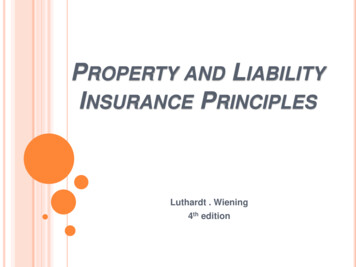
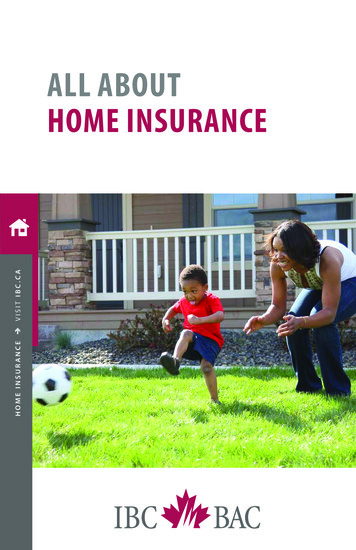
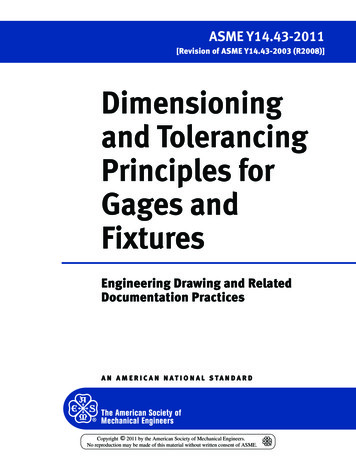
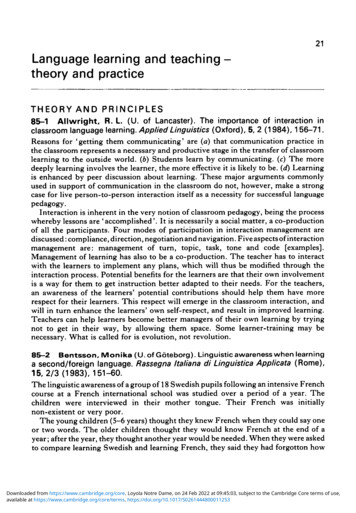
![[IV‐ADV‐9‐A] Tips and Tricks for Payroll and Human Resources](/img/9/tips-and-tricks-payroll-and-hr.jpg)
